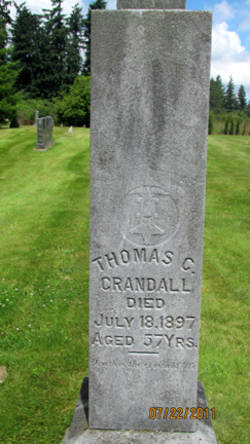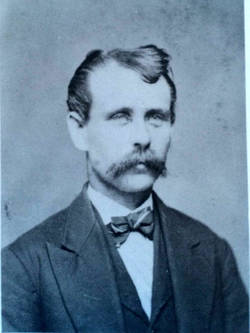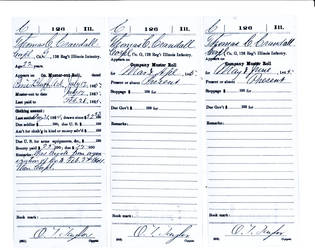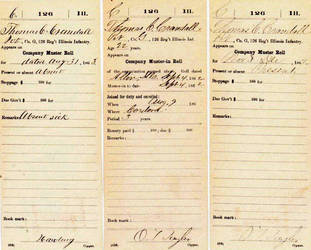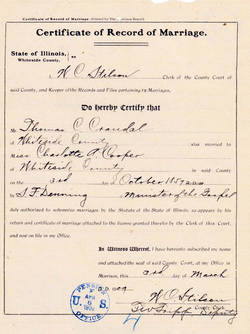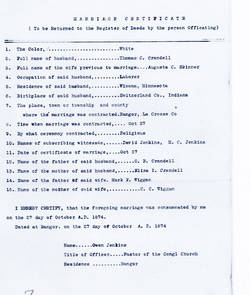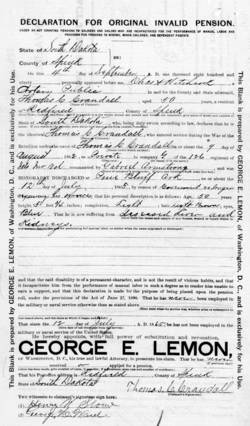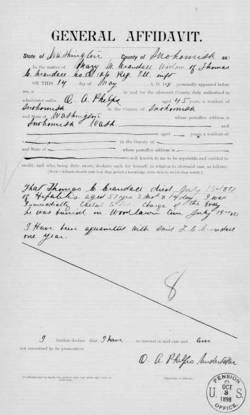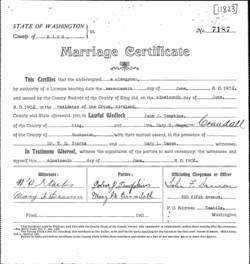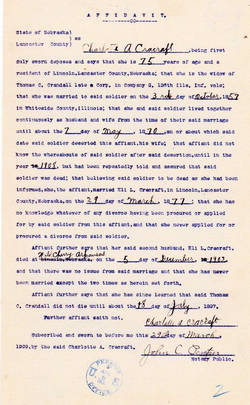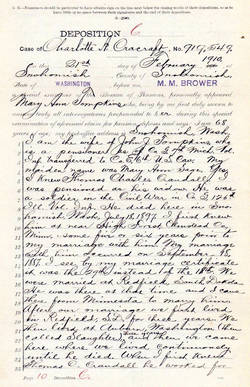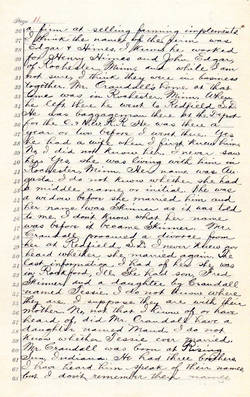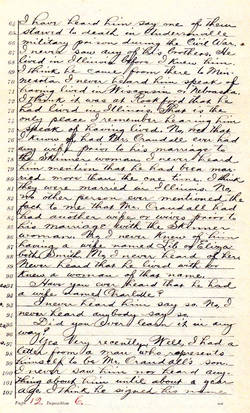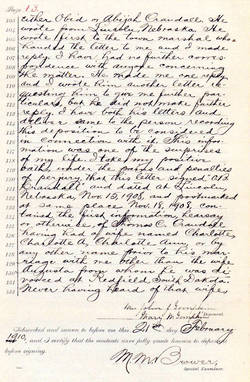Thomas C. Crandall
Representing: Union
G.A.R Post
- Oliver Morton Post #10 Snohomish, Snohomish Co. WA
Unit History
- 126th Illinois Infantry G
Full Unit History
126th ILLINOIS VOLUNTEER INFANTRY
Organized: Summer, 1862 Alton, IL
Mustered In: 9/4/62 Alton, IL
Mustered Out: June 4 and July 12, 1865 Pine Bluff, Ark.
Regimental History
REGIMENTAL HISTORY:
This three-year, western-theater regiment was organized at Alton, Illinois and mustered into Federal service on September 4, 1862. On November 20th it then moved to Columbus, Kentucky and thence to Bolivar, Tennessee. It served in Tennessee until July 24, 1863 when it embarked for Helena, Arkansas and marched with Union Gen. Steele's army with whom it participated in the capture of Little Rock on September 10th. The remainder of the 126th’s service was spent in Arkansas.
Regimental losses: Officers Killed or Mortally Wounded: 0; Officers died of Disease, Accidents, etc.: 4; Enlisted men Killed or Mortally Wounded: 6; Enlisted Men Died of Disease, Accidents, etc.: 192.
Soldier History
SOLDIER:
Residence: Cordova, Rock Co. IL Age: 22.3 yrs.
Enlisted/Enrolled: 8/9/62 Cordova, IL Rank: Pvt.
Mustered In: 9/4/62 Alton, IL
Mustered Out: 7/12/65 Pine Bluff, Ark.
Highest Rank: Cpl.
Family History
PERSONAL/FAMILY HISTORY:
Thomas Cole/Coal Crandall was born April 3rd or April 5th, 1840 in Cotton, Switzerland County, Indiana. He was the next to youngest of five sons born to Orin B. (b. 1806 NY) and Eliza I. (nee Bruner b. 1816 NY or PA) Crandall. In the U.S. census of 1850 the family patriarch was noted as being a "clergyman." The Crandall children were as follows: Wilder M. (b. 1833 IN), Richard H. (b. 1835 IN), Thomas C. (b. 1840 IN) Melville (b. 1843 IN) and Abijah S. (b. 1846 IN). After the birth of their youngest son the Crandall’s removed from Indiana and resettled in Illinois.
On 10/3/57 in Sterling, Whiteside County, Illinois 17.5 year old Thomas, without obtaining permission from his father, wed to twenty three plus year old Charlotte Ann Cooper (b. 1833 England). The two had reportedly known one another since they were children.
Following their marriage Thomas and Charlotte may have initially set up housekeeping and begun farming in Whiteside County, IL, but not long thereafter resettled near the community of Cordova or "Coe" in Rock Island County. Reportedly it was there the couples' five sons were born: Hamlet A. (b. 10/5/58), W. (b. ca. 1860), Alphonse/Alphonso Eustace (b. 3/23/62), Wilder B. (b. ca. 1866) and Otis (b. ca. 1868).
Thomas already had three sons when, on 8/9/62 in Cordova, Rock Island Co., Illinois he enlisted in the U.S. Army for a period of three years. By doing so he received a $100 bonus or "bounty," $25 of which was paid up front with the balance to be disbursed in later increments. Shortly thereafter he was mustered into Federal service as a private in company "G" of the 126th Illinois Infantry.
During the remainder of 1862 and through September, 1863, available company muster (present/absent) reports show Private Crandall present for duty. As of 8/31 of that year, however, he was listed as "absent sick." The nature of that sickness was - at that time - not documented, but in light of later illness absences, it was likely chronic diarrhea. In November, Thomas apparently returned to duty, not with his regiment but in some capacity at the Helena, Arkansas convalescent camp where he was recovering as, ca. 11/26/63 camp personnel requested he be issued orders to return to his unit. That being done, upon his return, on 2/27/64 he was promoted to the rank of corporal. Corporal Crandall would continue to suffer from acute diarrhea until around 6/120/64, but from that point onward through his final muster in July, 1865, was present for duty.
NOTE: During Thomas' Civil War military service his oldest brother, Wilder, also served, not in the 126th, but in the 93rd Illinois infantry. As Wilder enlisted not long after his younger brother, Thomas most likely was aware of the enlistment. What he may not have later known was that on 11/25/63 at Tunnel Hill, after the battle of Missionary Ridge in Tennessee, Wilder was captured by the enemy. Initially imprisoned in Richmond, VA, he was later transferred to Camp Sumter located at Andersonville, GA. There, on June 15, 1864, Private Wilder Crandall died from starvation and mistreatment.
**********************************************
Military service behind him, Thomas returned to Rock Island County, Illinois where he likely resumed farming. He also continued to grow his family with the addition of his two youngest sons. Somewhere along in here before the dawn of the 1870s the family may have moved - within Illinois - from Cordova in Rock Island County to Andalusia in that same county.
Circa the month of February, 1870 Thomas left his Illinois family and travelled to Nebraska allegedly for the purpose of establishing a homestead in the wilds of that state. It is unclear if he travelled there with his older brother Richard, or joined him there at his home located near Dunbar in Otoe County. Another, brother, Mel also had a homestead claim in that state.
Around early April of that same year Charlotte Crandall sold all of the family belongings in Illinois and she and her sons travelled southward to Nebraska to join Thomas in the community of Wilson Creek near Dunbar, Otoe County. There is some documental testimony to the fact that this move was unbeknownst to Thomas. Whether he had prior knowledge of the move or not, about the twenty third of April, after his wife and children had joined him in Nebraska, Thomas abandoned them and returned to Illinois.
In later years, two of Thomas' young sons would recall the Nebraska move and abandonment as follows - Wilder ca. aged 3 or 4 years: "Not over two weeks after mother joined father, father borrowed a horse from Uncle Richard and went away and we never saw nor heard from him again. He left the horse at Dunbar and Uncle Richard went over and got it. (I was only a) small child but I imagine I can see my father leave and he did so, turning in the saddle to my younger brother and myself (and saying) " You children better go in the house and get out of the wet and cold. As far as I know there had been no disagreements between my father and mother. After that I saw mother sitting and crying a number of times." Eustace age 10: - "All I know about the separation between father and mother (is that) father and Uncle Melville - I believe it was - got horses to go and get the mail and after they (got) to a certain going my father told his brother to take the horse back and that he was going to walk over a ways to see about renting a house. I do not know if Uncle Melville knew that father intended to leave us or not (but) some thought he did. I (do) know that other boys used to tease us by asking if our father has found his house yet..............."
After leaving his family and Nebraska Thomas allegedly returned to Rock Island County, Illinois living there, perhaps with his father for a time, and some say, across the Mississippi River in Davenport, Iowa with a woman named with the surname Smith. That may have been Elizabeth "Lib" Smith, although she later denied such a pairing with Crandall. If there was such a relationship with Smith it may have begun prior to Thomas' move to Nebraska and contained the roots of his family abandonment. It is highly possible that Thomas met Lib through her brother, Aaron, who had served in the same company and regiment as Thomas during the war. Some say that after his return to Illinois Thomas, who may then been selling sewing machines, reportedly passed this woman off as being his wife. At least one individual, however, knew of Thomas’ family situation and rebuked him for this new relationship.
Later investigation indicated that Thomas remained in Illinois for a year or two before travelling to Winona, Minnesota where he met the widowed Augusta C. (nee Wiggan) Skinner. The widow Skinner had one son, Fred, by her late husband. While information is far from clear on the matter, she may have owned a chicken ranch. After allegedly showing her a divorce decree from wife Charlotte, which Augusta thought was legitimate, "in good faith”, Thomas and she married on 10/27/74 in Bangor, La Crosse County, Wisconsin. They then apparently settled in Rochester, Minnesota. The union would produce one child: Maude Jessie or Jessie Maude Crandall. Later testimony by this daughter would indicate that her mother and father (Thomas) later moved to Wisconsin where Thomas squandered her mother's money and abandoned them both. This may have been around 1881.
The story of Thomas Crandall gets even more murky. At some point, perhaps while in Wisconsin either before his marriage to Augusta or after their separation circa 1881 Thomas reportedly sent a letter to his younger brother, Abijah, stating he was sick unto death and to please send money. His brother at once sent two $10 bills to the address directed, but in about two weeks the letter came back unopened with a note from the post office to the effect that Thomas C. Crandall never received any mail at that office. Further, within a month, or at least very soon after receipt of the returned letter, brother Melville received a newspaper clipping (from somewhere) stating that Thomas C. Crandall had died within the past few days. Were there two Thomas C. Crandall’s? This could help explain why the Crandall saga is so confusing........................We will likely never know.
***************************************************
At some date in either 1882 or 1883, near High Forest, Olmsted County, Minnesota, Mary M. Rogers, nee Sage, met Thomas. She would later testify: “When I (first) knew Thomas Crandall he worked for a firm selling farming implements. I think the name of the firm was Edgar and Hines. I know he worked for Henry Hines and John Edgar of Rochester, Minnesota...I think they were in business together. Crandall's home at the time was Rochester, Minnesota. He was married to Augusta." Mary and Thomas would meet again.
***************************************************
1885 or 1886. Somewhere in here Thomas departed Rochester, Minnesota and moved westward to Redfield Spink County, Dakota Territory where he obtained a job as depot baggage man for the C. & N.W. Railroad. It was in Redfield on September 17 of 1887 that he received a divorce from Augusta from whom he had reportedly separated or abandoned in 1881. On September 28/29, 1887 he re-wed to Mary Sage, now divorced from John M. Rogers. The Union would produce no children. That same fall Thomas began to receive medical treatment for kidney troubles from which he continuously suffered. According to a report from the time, “(He) had three very serious attack of bilious colic (between this period) and 1891. He was confined to his house for a period equal to six months between the time (he) started treatment and when stopped in/by 1891. (He) had to resign his job as baggage man (as he was) totally unfit at any time to perform manual labor."
As of 1890 Thomas and wife Mary were still in Redfield, now in the State of South Dakota. Around this time it appears he may have begun applying for a U.S. Government disability pension based on ailments which he traced back to his days of Civil War soldiering. From this paperwork process we first learn about Thomas' physical characteristics. At age 50 years he was described as being 5 feet, three quarter inches in height, having a light complexion, light brown hair and blue eyes.
It appears that late in the year of 1890 Thomas and Mary removed from South Dakota to Washington State where they settled in or near the community of Slaughter in south King County located in the western Puget Sound region of the state. Today, Slaughter is known as Auburn. The couple remained there for only a brief time as by 1893 they had moved northward to the community of Snohomish located in Snohomish County. Interestingly - as well as confusingly - that same year, from Houghton, King County, Washington (now part of Kirkland) Thomas requested admission to the government pension system but was rejected because his alleged disabilities had no financial “ratability.”
Whatever his inter-county moves were, on June 10, 1897, in Snohomish County Thomas was granted a $6 per month governmental disability pension stipend retroactive to July 30th of the previous year. Basis for the pension was listed as rheumatism, disease of the backs, kidney disease, liver problems, gall stones, nervousness and lumbago. All the above had almost completely restricted his ability to earn a living performing manual labor from 1894 into 1897.
Thomas was never able to reap the benefits of his newly pensioned status as almost immediately after the pension was granted he died. His death date was July 18, 1897. Place of passing was Snohomish, Snohomish County, Washington. He was subsequently buried in that community's Woodlawn Cemetery. Following Thomas's death Mary, residing in Snohomish, Snohomish County, WA, applied for and was granted at least a portion of her late husband's newly acquired pension stipend. On June, 19, 1902 Mary remarried to one J.J. Tompkins - also a civil War veteran (d. 8/16/16 buried Woodlawn Cem). Because of that remarriage she was dropped from Thomas' pension.
Such would seem to be the end of the tale of Thomas C. Crandall, but it was to prove not to be. We now return to the life of Charlotte Crandall, Thomas' original wife.
*****************************************
Following the abandonment of she and her children, Charlotte remained in Arkansas and, having reportedly heard of Thomas' death, remarried to a Eli Cracraft. Following the death of Cracraft in 1902, Charlotte stayed in Arkansas until 1905 then moved to Dalton, Lane County, Kansas to live with her brother Wiler. She remained there until September, 1907 when she moved to the home of her son, Otis, in Nebraska. It was Otis who inquired to the U.S. Government regarding whether an application for a pension had ever been made by anyone claiming to be the widow of Thomas C. Crandall. As far as Otis was concerned, any pension funds based on his late father's Civil War soldiering should rightfully belong to his mother, Charlotte. At his bequest an investigation was begun which brought to light many of the details written herein pertaining to Thomas’ “post-abandonment” life.
The pension-chasing investigational process would drag on for nearly two years, costing an untold amount of money to seek out and interview those involved in Thomas' "second" life. In the end, on 12/29/10 the pension office came up with the following finding: " A search was made of the divorce records in the various jurisdictions where the parties resided subsequent to their separation, which shows that that they were never divorced and as a consequence, their marriage, valid at inception, subsisted until the soldiers death and as a corollary, the claimant became his lawful widow at the time.
This conclusion, however, does not carry with it the admission of the claimant's title to pension as such Widow, for at the date of the soldier's death she was living with Cracraft in the relationship of husband and wife under a ceremonial marriage which she insists was entered into in good faith in 1877, and which relationship subsisted for 25 years and until Cracraft's death in 1902. While it is clear that the claimant's ceremonial marriage with Cracraft was void at inception, it is so that she continued to live with him in the relation of husband and wife after the removal of the impediment by the death of the soldier, July 19, 1897; impediment that they were so known, recognized and reputed and under a showing of this character it will be held that a marriage as at common law arose co instant (underlined), between the claimant and Cracraft upon the death of the soldier and as this relationship continued until Cracraft's death, she became his lawful widow at that time. This in the interests of decency and morality for if her relation with Cracraft was not matrimony after the soldier's death, it was illicit or meretricious, and whatever its character, she would be estopped from asserting title to pension as soldier's widow under the facts and circumstances developed in this case."
In short, Charlotte was not entitled to any part of Thomas' pension. So, FINALLY, ended the spider's-web tale pertaining to the life of Civil War soldier Thomas C. Crandall.
Final notes: Charlotte Crandall/Cracraft died 3/22/13 in Independence, Jackson County, Missouri. She is buried in that city’s Woods Chapel Cemetery under the name Sharlotta Carcraft.
As for Mary Crandall/Tompkins, she died 9/23/16 and is buried beside J.J. Tompkins at Woodlawn Cemetery.
Cemetery
Buried at Woodlawn Cemetary Snohomish
Adopt-a-Vet Sponsor
Data Provider: Holly Cracroft Pace
Parovan, Utah
